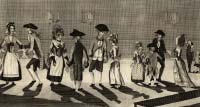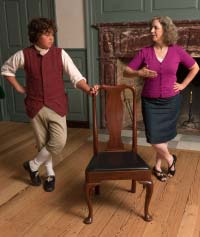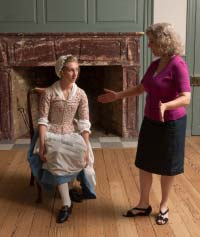Online Extras
Extra Images

The practiced arrangement of hands and feet, the tilt of the head, posture–all expressed correct deportment to polite society. Anne Peeters and Alex Boscana assume the positions.

Colonial Williamsburg dancers at the Governor’s Palace. Refined deportment connoted inner virtue, not to mention elite status.

Colonial Williamsburg
The Village Assembly, where those of a modest, middling sort emulated their social betters in the polite arts of dance and courtesy.
Department of Deportment
Stances and dances made the eighteenth-century man—and woman
by James Breig
In 1788, writing to Thomas Jefferson, then the United States’ ambassador to France, George Washington described a businessman on his way to Paris as “full of affability, good nature, vivacity and talents. As you will also find in him a deportment calculated to do credit to the national character, I cannot hesitate to believe that you will be desirous of having opportunities of being useful to him.”
An obituary a year earlier for James Baron of Hampton, Virginia, a Revolutionary War veteran, credited him for his “truly benevolent deportment,” which “endeared him to his acquaintances” and made “his death regretted and lamented.”
In 1785, a friend, writing to John Adams, then in Europe, reported that his son, John Quincy Adams, was “Pleasing to The Old, as he is Respectfull in his Deportment; to The Young: as he affects no Superiority over the Youth of his Country.”
What were these eighteenth-century people talking about when they used the word “deportment”? To modern ears, the term refers to bearing, as one dictionary puts it, and conjures images of people walking with books balanced on their heads. But in the 1700s, people understood deportment not only as an upright stance but also as moral uprightness.
In his book The Refinement of America: Persons, Houses, Cities, Richard L. Bushman writes: “The physical and moral had been joined in Western thought ever since the genteel ideal was revived in the Italian renaissance and incorporated into courtesy books, what we would call books of manners. The idea was that the beauty of the person’s physical appearance, and his or her moral qualities were all of a piece, summed up in the word ‘refinement.’ In the eighteenth century, it was considered the highest form of civilized life, rivaling Christianity.”
Achieving that status was often an accident of birth, says Cathy Hellier, a Colonial Williamsburg historian: “People assumed that people of the gentry classes and above—that is, those with an ancestry of ‘gentleman’ and above—had received a liberal education and acted with honor. It was not always true, of course, but that was the ideal. Part of that education, and also a result of ‘keeping good company,’ was a deportment suitable to the person’s status. If a person stood, walked, and danced like a gentleman, he probably was one in all respects.”
It was, therefore, essential for people to improve their outer deportment to embody their inner deportment. Members of the upper classes had to reflect their position; those hoping to move upward in society had to achieve an external appearance that signaled their worthiness for being accepted. Such behavior was sought in people of all classes. A 1787 want ad in the Pennsylvania Gazette, for example, sought “a single man who understands the cutlery business, especially making scythes.” The employer desired someone adept at “workmanship and deportment.”
Among the examples of a man marrying inner and outer personae was Washington, who formed himself into what he wanted to be by dressing the part, studying the behavior of his superiors and imitating it, and living the virtues he knew others treasured. As a teenager, he copied “Rules of Civility & Decent Behaviour In Company and Conversation,” 110 aphorisms French Jesuits set down in the sixteenth century. Among the rules were “if You Cough, Sneeze, Sigh, or Yawn, do it not Loud but Privately,” “Reproach none for the Infirmaties of Nature, nor Delight to Put them that have in mind thereof,” and “Associate yourself with Men of good Quality if you Esteem your own Reputation; for ’tis better to be alone than in bad Company.”
Persons aiming to improve their deportment had resources to help them. Teachers knew their duties extended beyond instruction in grammar, as evidenced by an ad that appeared in 1771 in the Pennsylvania Gazette. Matthew Maguire, who taught young ladies English, writing, and mathematics, assured “his kind employers, that while he endeavours with assiduity to give his pupils a perfect knowledge of the above branches, he shall consider it an indispensible part of his duty, to be particularly careful of their moral deportment.” Hellier says such instruction began at home: “Parents provided an early example. Observation was another way the intelligent could acquire the outward signs of gentility. Even if a person was not of a status to mix at private social gatherings with gentry, they could observe them at public places, such as church, on the street, the theater, shops.”
She points out that the rules of etiquette that bound genteel behavior also were published in books. An example is The Polite Academy, issued in London in 1762, which instructed children in proper behavior, telling girls, for instance, how to receive a gift: “Let your Left-Arm hang to your waist, bringing it a very little forward. Bring the Hand of that Arm forward to the Waist. Let it be kept at the Height of the Point of your Shape, and turn the Palm of it inward.” The instruction had nineteen steps. “The presses turned out manners books by the score in the eighteenth century,” Bushman writes. “One of the most famous was Lord Chesterfield’s Letters to His Son, wherein he laid out the rules of genteel behavior in letter after letter. Ideally, one learned refinement from circulating with refined persons; but, for the aspiring middle class, manners books had to serve.”
Philip Dormer Stanhope, Earl of Chesterfield, penned advisory missives to his son with the hope that his advice would be taken in and lived out. “Frivolous curiosity about trifles,” he wrote in one letter, “and a laborious attention to little objects which neither require nor deserve a moment’s thought, lower a man; who from thence is thought (and not unjustly) incapable of greater matters.” In another letter, he wrote: “People hate those who make them feel their own inferiority. Conceal all your learning carefully.”
Chesterfield’s female counterpart was Hester Chapone, an Englishwoman who wrote Letters on the Improvement of the Mind, Addressed to a Young Lady. “It must be impolite,” she said, “to hurt the temper or to shock the passions of those you converse with. . . . Set your companions in the most advantageous point of light, by giving each the opportunity of displaying their most agreeable talents, and by carefully avoiding all occasions of exposing their defects.”
In the late 1700s, Thomas Percival published A Father’s Instructions in London, covering behavior from cruelty to insects and care for birds’ nests to tenderness toward mothers and the “true enjoyment of life.” He taught through poems, allegories, and stories. In Lessons in Elocution; Or, A Selection of Pieces in Prose and Verse for the Improvement of Youth, published in Philadelphia in 1793, William Scott included illustrations for proper carriage, including one that demonstrates “the attitude in which a boy should always place himself, when he begins to speak. He should rest the whole weight of his body on the right leg; the other, just touching the ground, at the distance at which it would naturally fall, if lifted up to shew that the body does not bear upon it. The knees should be straight, not perpendicular, but inclining as far to the right, as a firm position on the right leg will permit.”
With their parents’ advice, teachers’ admonitions, books’ guidelines, and dancing masters’ training, young men and women in the 1700s could attempt to acquire good deportment. When they succeeded, they gave off multiple signals of their status to others. There were “proper ways to sit, stand, and walk,” Hellier says. “Gentlemen, for example, generally stood with feet in fourth position, back leg straight, and weight on this leg, front leg bent. There were several acceptable positions for his arms, among them sticking one hand in his unbuttoned waistcoat.
“An upright carriage was also important. For example, a gentleman could lean on a table, but he kept his back straight, rather than hunching, when he did so. Ladies, with the help of stays, also had an upright carriage, but a much more circumscribed way of standing; they had physically less freedom than gentlemen. For example, when they were standing, ladies generally curved their arms in front of them and rested one hand in another, unless they were holding a fan. If they held a fan, there were several acceptable positions to do this, all delineated in the etiquette books.”
The physical training required to attain grace and balance often fell to dancing instructors. Hellier says that “dancing masters and mistresses actually taught how to stand, sit, walk, hand objects to others, as well as dance—all considered necessary parts of genteel behavior.” But they could be rod-wielding taskmasters.
In his 1773–74 diary of being a tutor for the Carter family in Virginia, Philip Vickers Fithian described a dancing-master who was so “strict . . . that he struck two of the young Misses for a fault in the course of their performance, even in the presence of the Mother of one of them! And he rebuked one of the young Fellows so highly as to tell him he must alter his manner, which he had observed . . . to be insolent, and wanton.”
Chesterfield urged his son to have a dancing-master “teach you every genteel attitude that the human body can be put into: let him make you go in and out of his room frequently, and present yourself to him, as if he were by turns different persons; such as a minister, a lady, a superior, an equal, an inferior, etc.” That role-playing was important, Hellier says, because “etiquette required that people be able to recognize or determine the most important person in the room—or alternatively, the oldest—and observe descending rank from there, so that they could properly place themselves in rank in the room.
“Etiquette books are filled with the rules for how to treat persons of lower, equal, and greater rank. The ability or inability to follow these rules usually divided gentry from those of lesser status. Polite speech was also a sign of gentility. There was a whole vocabulary to be used when one intruded on the time or possessions of someone else, even in polite ways like invitations and asking someone to dance. Those of lower status usually were unsuccessful in navigating this sea of polite speech.”
With so many actions, words, behaviors, and manners to memorize and make part of one’s life, “the problem for would-be ladies and gentlemen was that they could imitate one detail or another of proper behavior, but they could not blend them into a smooth and integrated whole,” Bushman writes. “That took practice and close observation of proper models. Try as they would, aspirants to genteel status fouled up on some detail of dress or behavior, giving away their lack of proper breeding.”
When those who strove for gentility gave themselves away as parvenus, or when those in the upper classes didn’t live up to their inherited status, penalties could be exacted. Bushman says, “People without manners were considered intruders who had to be expelled from polite company.” Hellier: “A slovenly carriage, inability to dance, or poor social skills could stand in the way of a good marriage and invitations to good company. Ridicule, openly and more clandestine, was also a consequence of inability or unwillingness to go along with the rules. People in the eighteenth century did not hesitate to ridicule those who pretended to gentility but failed in the execution.”
Such rules of deportment might seem to be relics, but echoes of them can be heard in the twenty-first century. “We often say that manners have deteriorated in modern times, as indeed they have in parts of society,” Bushman writes. “It is even considered a mark of authenticity to act a little rude or dress shabbily. But when the time comes to impress someone when applying for a job or meeting your girlfriend’s parents, manners and polite dress suddenly come out of the closet and are put on, if only for show.”
Hellier says that “a remnant of polite speech survives in formal invitations: ‘The pleasure of your company is requested. . . .’ A more upright carriage is still considered a sign of respect to your company, but the occasions for its use are severely limited to formal occasions these days.
“For example, we would sit straight and stand straight if we visited the governor’s mansion or the White House, or for dinner with the boss, or a formal work-related event. Proper dress is expected at these events. A good handshake corresponds to the eighteenth century’s well-performed bow or curtsey. Proper table manners are still considered a telltale sign of good upbringing. Social awkwardness is still viewed as a liability.”
James Breig, an Albany-based writer and editor, contributed to the autumn 2011 journal an article detailing what happened in Williamsburg after Virginia’s government left for Richmond in 1780.





